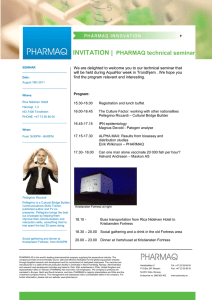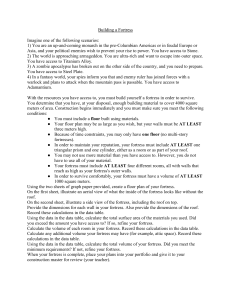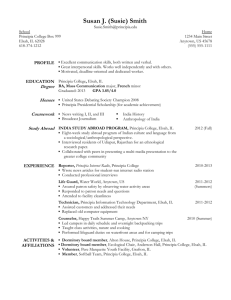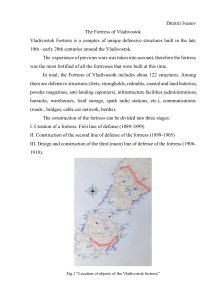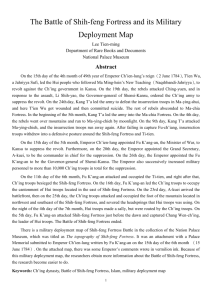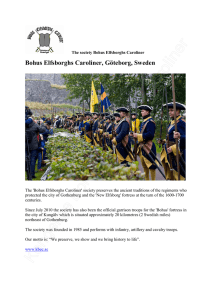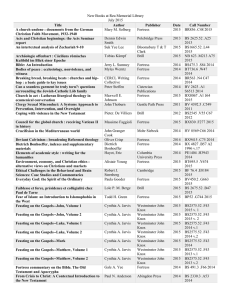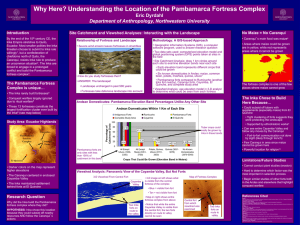Roman Military Camps
advertisement
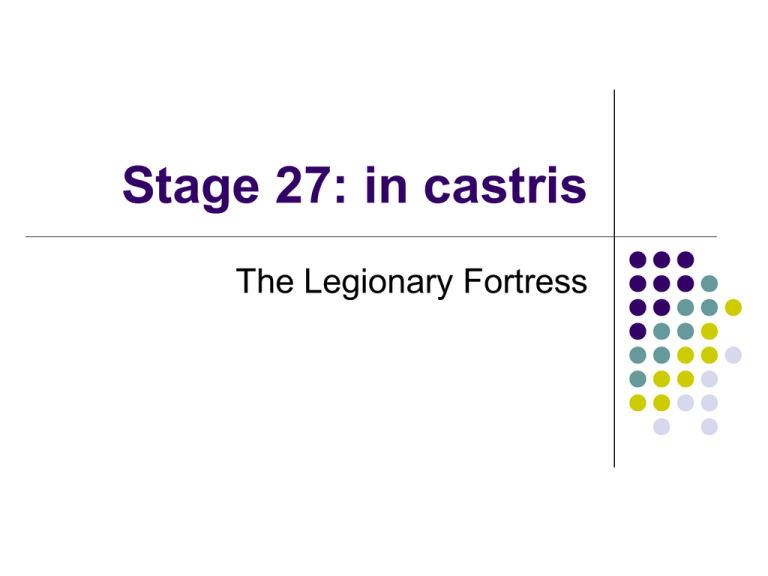
Stage 27: in castris The Legionary Fortress The Legionary Fortress The fortress where a legion lived when not on campaign was like a fortified town which covered 50-60 acres (about one third of Pompeii) There was a standard pattern for the layout Chief buildings were the principia, praetorium, valetudinarium, and the horrea Roads were laid out in a grid pattern although there were three main streets: 1) via praetoria-from the main gate to the front entrance of the principia; 2) via pricipalis-across the whole width of the fortress; and 3) via quintana-behind the principia and across the width of the fortress The fortress was surrounded by a ditch, vallum, which was an earth wall or mound, and battlements, with towers at the corners and at intervals along the sides. Each side had a fortified gateway. Principia The principia was a large and impressive building at the heart of the fortress Visitors would enter a flagstone courtyard surrounded on three sides by a colonnade and storerooms, on the far side was a large basilica where the commander worked with his cofficers, interviewed important local people, and administered military justice Major Buildings Plan of a legionary fortress Sacellum In the center of the far long wall of the basilica and directly facing the main gate was the most sacred place in the fortress, the sacellum, or chapel. The standard of the legion was housed here, the aquila. It was made of gold and in its talons clutched a bundle of golden darts that represented the thunderbolts of Jupiter. The aquila represented the spirit of the legion and aroused feeling of intense loyalty and an almost religious respect. To lose it in battle was the worst possible disgrace and misfortune; this rarely happened. The aquilifer was the soldier who looked after the aquila and carried it in battle. He was a soldier of the first cohort. Aquilae Praetorium On either side of the sacellum were the rooms for payroll and paperwork, close by was the safe The praetorium was behind the principia and was a luxurious house in the style of an Italian domus urbana which provided the legatus and family comforts they required for a civilized life: central heating, garden, and a private suite of baths Valetudinarium The hospital contained many sick wards which were designed to ensure peace and quiet for the sick and injured There was also a large reception hall to accommodate an influx of casualties from battle and a small operating theater equipped with running water Horrea Designed to keep grain dry and cool for long periods In the first century AD they were made out of wood, but from the second century on they were made of stone Long, narrow building Roof had overhanging eaves to carry the rain water away Floor was supported by small piers or low walls which allowed air to circulate freely underneath which prevented damp from rising Could store grain for one or two years Barracks Housing 5000-6000 men Long, narrow, rectangular buildings were divided into pairs of rooms, each pair providing accommodation for an eight man section (contubernium) Each section cooked for itself on a hearth in the front living room Each block housed a century At the end of the block was the larger suite of rooms for the centurion Bath House Important for hygenic and social reasons Consisted of a tepidarium, caldarium, and frigidarium Sometimes it was outside the fortress by a stream, or inside the fortress Amphitheater Always outside the fortress Same shape and layout as the civilian amphitheater and could seat the whole legion Used for ceremonial parades, weapon training, and displays of tactics, as well as for occasional gladiatorial shows Local Citizens Civilians tended to gather around military bases Traders who set up bars to sell food and drink came first This was a place for soldiers to also meet local girls Soldiers were not legally allowed to marry, but the army allowed unofficial unions The father lived in the barracks, while the family lived just outside, and his sons enlisted at 18 or 19 Many of these settlements (vici) developed into towns and even became self governing (Eboracum (York)) Military bases played an important role in the development of civilian town life Eboracum (York) DEFINITIONS Principia-headquarters Praetorium-the living-quarters of the commanding officer Valetudinarium-the hospital Horrea-granaries Via praetoria-street which ran from the main gate to the front entrance of the principia Via principalis-street which extended across the whole width of the fortress making a T-junction with the via praetoria just in front of the principia Via quintana-street which passed behind the principia and also extended across the width of the fortress DEFINITIONS Vallum-ditch surrounding the fortress which was an earth wall or mound, and battlements, with towers at the corners and at intervals along the sides Basilica-great hall, where the commander worked with his officers Sacellum-chapel Aquila-image of an eagle perched with outspread wings on the top of a pole Aquilifer-eagle-bearer Domus urbana-luxurious house with comforts expected for a civilized life Contubernium-long, narrow, rectangular buildings providing accomodation for an eight man section Vici-settlements outside of military bases
